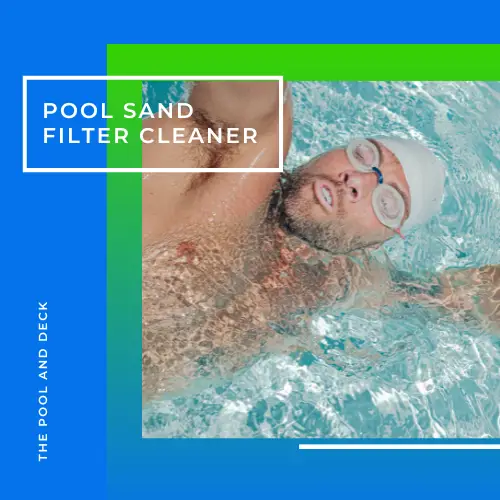Pool Sand Filter Cleaner: Results in Amazing Benefits!
Table of Contents
What Is A Pool Sand Filter Cleaner?
Why do you need a pool sand filter cleaner when you can backwash to clean out the debris trapped by the sand filter? What is it anyway?
Pool sand filter cleaner has an enzymatic or chemical agent that breaks up the trapped debris, clinging algae strands and slimy, greasy gunk. Only then will the backwashing be able to remove these and restore the sand back to its original clean state.
Pool sand filters work by trapping dirt and debris from the water as it passes through the sand grains. Over time, the sand in the filter becomes clogged with these contaminants and the water flow through the filter slows down.
While backwashing will remove most of the debris trapped by sand, it doesn’t always get everything. That’s where a pool sand filter cleaner comes in. The cleaner will chemically act on the sticky contaminants and free them from the sand grains.

How Does Pool Sand Filter Cleaner Work?
The active ingredients in a pool sand filter cleaner may be enzymes, natural bacteria, chemical agents or a combination. The active ingredient breaks down the contaminants, biologically or chemically, so as to dissolve and loosen them from the sand grains.
Enzymatic cleaners work by breaking down the organic material in the filter, such as oils, lotions, and other debris. The enzymes target the carbon-based molecules and break them down into smaller particles that can be easily removed during the backwashing process.
Chemical-based cleaners, on the other hand, work by dissolving or loosening the trapped debris in the filter. These products are surfactants or degreasers and contain acidic or alkaline compounds that can break down the particles and help them wash away during the backwash cycle.
Not all pool sand filter cleaners are created equal. Some may contain harsh chemicals that can damage the pool filtration system or harm swimmers. Make sure to use a high-quality pool sand filter cleaner from a reputable brand.
As an Amazon Associate, I earn from qualifying purchases.
Recommended Products
What Is the Correct Way to Deep Clean Sand Pool Filter?
Want your backyard pool to have crystal clear water? Well then make sure that the sand in the pool filter is as clean as new. Backwashing is the way to clean out the media in a sand or DE pool filter.
Keep an eye on the filter pump pressure gauge. It is time to backwash whenever the pressure is around 10 psi higher than the normal psi reading. Normal psi reading is given in the user manual. In any case it is the reading you will see when the sand is new or just after the filter has been successfully backwashed.
In case backwashing is not reducing the pump pressure to normal psi, then it is time to use the pool sand filter cleaner. Think of it as the deep clean!
TIP: It is best to start the process in the evening so that the cleaner can work its magic during the night.
Here is a step-by-step process to deep clean the pool sand filter:
Backwash the Sand Filter
Turn off the pump and set the multiport valve to the “Backwash” position. Attach your backwash hose to the waste port. Now turn on the pump and let it run for 2-3 minutes or until the water in the sight glass is clear.
Turn off the pump and set the multiport valve to the “Rinse” position. Turn on the pump and let it run for 30 seconds to flush out any remaining debris.
Add Pool Sand Filter Cleaner
With the pump turned off, turn the multiport valve setting to “Filter”. Now open the pump’s strainer and pour 8 oz of the pool sand filter cleaner liquid into the strainer basket.
Run the pump for just 15 seconds or so. This is enough time to get the cleaner into the filter. Turn off the pump and let the cleaner get to work overnight.
Backwash the Sand Filter Again
Backwash the filter again in the morning. This backwash will flush out the stuff that was not removed in the first backwash and that the cleaner has now dislodged.
Turn off the pump and set the multiport valve on “Filter”. Turn on the pump and check the reading on the pressure gauge. It should be in the normal range!
Thank you very much for reading the post. I do hope you found it informative and helpful.






